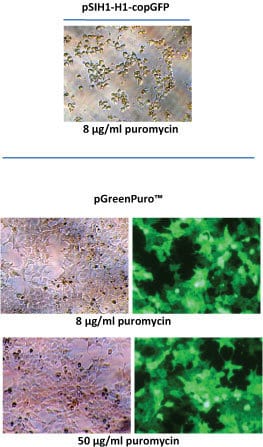pGreenPuro Scramble Hairpin Control (EF1α) shRNA Expression Lentivector
Products
| Catalog Number | Description | Size | Price | Quantity | Add to Cart | |||
|---|---|---|---|---|---|---|---|---|
| SI506-000PA-1 | pGreenPuro Scramble Hairpin Control - Construct (EF1) | 10 µg | $792 |
|
||||
Overview
Overview
Set up stable, heritable RNAi
Well-regarded in the industry for high, reliable gene expression, SBI’s lentiviral vectors also efficiently deliver RNAi. Generate cell lines with stable, heritable gene silencing to develop a throrough understand of the target gene’s function. Our HIV-based pGreenPuro (EF1α) shRNA Cloning and Expression Lentivector shRNA Cloning and Expression Lentivector drives expression of your shRNA template from the H1 promoter, and after processing in the cell, your shRNA will be converted into siRNA. The vector also co-expresses puromycin and copGFP from the moderate EF1α promoter, with co-expression mediated by a T2A element.

References
How It Works
How It Works
Using SBI’s shRNA lentivectors to produce siRNAs
To produce siRNAs for RNAi using the pSIF1-H1-H2Kk Cloning and Expression Lentivector, first clone your shRNA template into the unique BamHI or EcoRI sites in the vector. After packaging and transduction, the vector will integrate into the genome and your shRNA will be transcribed from the H1 promoter using RNA polymerase III. The shRNA is transcribed as a single strand with a sense-loop-anti-sense structure that folds into a hairpin, and is then processed by DICER to produce an active siRNA molecule (Figure 1).
Figure 1. Generating siRNA from the pGreenPuro (EF1α) shRNA Cloning and Expression Lentivector.
Supporting Data
Supporting Data
Using SBI’s shRNA lentivectors—selecting for transductants
Figure 2. Using SBI’s shRNA lentivectors. Easily select transductants with one of our markers—these examples show selection using GFP and puromycin markers on either the pSIH1-H1-copGFP (Cat.# SI501B-1) or pGreenPuro™ (Cat.# SI505A-1VB-1) shRNA Cloning and Expression Lentivectors.
FAQs
Documentation
Citations
Related Products
Products
| Catalog Number | Description | Size | Price | Quantity | Add to Cart | |||
|---|---|---|---|---|---|---|---|---|
| SI506-000PA-1 | pGreenPuro Scramble Hairpin Control - Construct (EF1) | 10 µg | $792 |
|
||||
Overview
Overview
Set up stable, heritable RNAi
Well-regarded in the industry for high, reliable gene expression, SBI’s lentiviral vectors also efficiently deliver RNAi. Generate cell lines with stable, heritable gene silencing to develop a throrough understand of the target gene’s function. Our HIV-based pGreenPuro (EF1α) shRNA Cloning and Expression Lentivector shRNA Cloning and Expression Lentivector drives expression of your shRNA template from the H1 promoter, and after processing in the cell, your shRNA will be converted into siRNA. The vector also co-expresses puromycin and copGFP from the moderate EF1α promoter, with co-expression mediated by a T2A element.

References
How It Works
How It Works
Using SBI’s shRNA lentivectors to produce siRNAs
To produce siRNAs for RNAi using the pSIF1-H1-H2Kk Cloning and Expression Lentivector, first clone your shRNA template into the unique BamHI or EcoRI sites in the vector. After packaging and transduction, the vector will integrate into the genome and your shRNA will be transcribed from the H1 promoter using RNA polymerase III. The shRNA is transcribed as a single strand with a sense-loop-anti-sense structure that folds into a hairpin, and is then processed by DICER to produce an active siRNA molecule (Figure 1).
Figure 1. Generating siRNA from the pGreenPuro (EF1α) shRNA Cloning and Expression Lentivector.
Supporting Data
Supporting Data
Using SBI’s shRNA lentivectors—selecting for transductants
Figure 2. Using SBI’s shRNA lentivectors. Easily select transductants with one of our markers—these examples show selection using GFP and puromycin markers on either the pSIH1-H1-copGFP (Cat.# SI501B-1) or pGreenPuro™ (Cat.# SI505A-1VB-1) shRNA Cloning and Expression Lentivectors.



